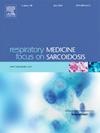Asthma-OSA overlap syndrome: A distinct endophenotype?
IF 3.1
3区 医学
Q2 CARDIAC & CARDIOVASCULAR SYSTEMS
引用次数: 0
Abstract
Purpose
Asthma and obstructive sleep apnea (OSA) are two respiratory diseases that often may coexist, resulting in Alternative Overlap Syndrome (aOVS), which is still underestimated and underdiagnosed.
Objectives
This state-of-art review aims to describe the current evidence on aOVS, including its pathophysiology, clinical, functional and therapeutic implications. A secondary objective is to assess whether aOVS can be identified as a distinct endophenotype needing personalized diagnostic and therapeutic strategies.
Results
Asthma and OSA share several common risk factors, including obesity, gastroesophageal reflux disease (GERD) and rhinitis, which contribute to the pathogenesis of aOVS. From a pathophysiological perspective, aOVS has unique characteristics such as a low arousal threshold, nocturnal bronchial hyperresponsiveness and autonomic nervous system (ANS) dysfunction. These features lead to sleep fragmentation, altered ventilatory control, increased upper and lower airway resistance, and airway and systemic inflammation. From a functional perspective, patients with aOVS present lower FEV1 and increased nocturnal hypoxemia compared to subjects with only asthma or only OSA. From a clinical perspective, aOVS is linked to reduced asthma control, frequent exacerbations, and a lower quality of life. From a therapeutic perspective, continuous positive airway pressure (CPAP) has a positive impact on asthma control, symptom burden and inflammatory response. Weight loss, GERD and rhinitis management, and emerging therapies such as GLP-1 agonists and biological agents may provide additional benefit.
Conclusions
Current evidence suggests that aOVS may be considered a distinct clinical endophenotype. Its identification is crucial to ensure timely diagnosis, improve management, and direct future research about long-term outcomes and personalized therapy.
哮喘-呼吸暂停重叠综合征:一种独特的内表型?
目的哮喘和阻塞性睡眠呼吸暂停(OSA)是两种经常可能共存的呼吸系统疾病,导致选择性重叠综合征(aOVS)的发生,目前仍被低估和诊断不足。本综述旨在描述目前关于aOVS的证据,包括其病理生理、临床、功能和治疗意义。第二个目的是评估aOVS是否可以被确定为一种独特的内表型,需要个性化的诊断和治疗策略。结果哮喘和OSA具有肥胖、胃食管反流病(GERD)和鼻炎等共同的危险因素,共同参与了aOVS的发病机制。从病理生理学角度来看,aOVS具有低唤醒阈值、夜间支气管高反应性和自主神经系统功能障碍等独特特征。这些特征导致睡眠破碎、通气控制改变、上呼吸道和下呼吸道阻力增加以及呼吸道和全身炎症。从功能角度来看,与仅哮喘或仅OSA患者相比,aOVS患者FEV1较低,夜间低氧血症增加。从临床角度来看,aOVS与哮喘控制减少、频繁恶化和生活质量降低有关。从治疗角度来看,持续气道正压通气(CPAP)对哮喘控制、症状负担和炎症反应均有积极影响。减肥、胃食管反流和鼻炎治疗,以及诸如GLP-1激动剂和生物制剂等新兴疗法可能提供额外的益处。结论目前的证据表明,aOVS可能被认为是一种独特的临床内表型。它的识别对于确保及时诊断,改善管理,指导未来长期结果和个性化治疗的研究至关重要。
本文章由计算机程序翻译,如有差异,请以英文原文为准。
求助全文
约1分钟内获得全文
求助全文
来源期刊

Respiratory medicine
医学-呼吸系统
CiteScore
7.50
自引率
0.00%
发文量
199
审稿时长
38 days
期刊介绍:
Respiratory Medicine is an internationally-renowned journal devoted to the rapid publication of clinically-relevant respiratory medicine research. It combines cutting-edge original research with state-of-the-art reviews dealing with all aspects of respiratory diseases and therapeutic interventions. Topics include adult and paediatric medicine, epidemiology, immunology and cell biology, physiology, occupational disorders, and the role of allergens and pollutants.
Respiratory Medicine is increasingly the journal of choice for publication of phased trial work, commenting on effectiveness, dosage and methods of action.
 求助内容:
求助内容: 应助结果提醒方式:
应助结果提醒方式:


